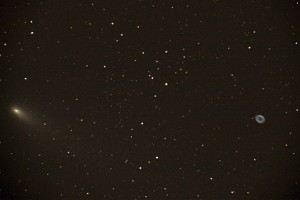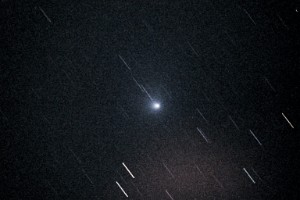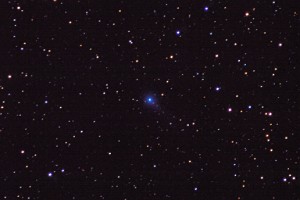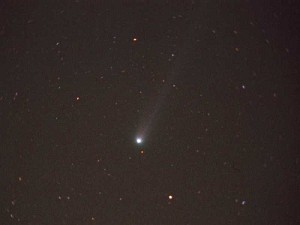
M57 and Comet Schwassmann-Wachmann 3

Comet Linear C/2000 WM1
Object: Comet Linear C/2000 WM1 Date: Nov 21, 2001 Exposure: 40 Minutes Film: Kodak LE400 Equipment: Losmandy G-11 GEM, ETX90 piggybacked on 10" f/10 Meade OTA Autoguider: SBIG ST-4 guiding on the Comet. Camera: Nikon F Hardware & Software: HP S20xi film scanner & Hamrick Vuescan 7.1.1. The scan was processed, and cropped, using Picture Window 3.0. Info: Comet Linear C/2000 WM1 was photographed on November 21, 2001, The slow photographic speed of the ETX proved to be a challange for this shot. I'm also sure that the 4.5 mag skies this shot was taken from played a roll. You may notice that the stars are trailed in the image, this is because the autoguider was tracking the comet and it is quickly moving relative to the background stars. I used the 10" as my guide scope for the ST-4. Even with the 10" the ST-4 needed a 6 second exposure with the gain set to 3x in ccdtrack in order to track on the comet. Interestingly, at one point during a different exposure, a star entered the ST-4's guide box. When the star left the guide box, ccdtrack kept right on guiding on the comet. This resulted in ccdtrack averaging the positions of the star and the comet and all the star trails show a kink at that point.

Comet Linear C/2001 A2 (Close)
Object: Comet Linear C/2001 A2 Date: July 14, 2001 Exposure: 10 Minutes Film: Kodak Ektachrome E200 Equipment: Losmandy G-11 GEM, Tokina ATX 80-200 @ 80mm f/5.6 piggybacked on 10" f/10 Meade OTA Autoguider: SBIG ST-4 guiding on the Comet. Camera: Minolta SRT-102 Hardware & Software: HP S20xi film scanner & Hamrick Vuescan 7.1.1. The scan was processed, and cropped, using Picture Window 3.0. Info: Comet Linear C/2001 A2 was photographed on July 14, 2001, It is now on its way away from the sun but It has been amazing astronomers because its brightness keeps surpassing predictions. You may notice that the stars are slightly trailed in the image, this is because the autoguider was tracking the comet and it is quickly moving relative to the background stars.

Comet C/1996 B2 Hyakutake
Taken 26 March 1996. This 5 minute exposure on Kodak Gold 100 was taken with a Minolta X-700 using a 50mm f1.7 lens and a 2x teleconverter. The negative was scanned onto a PhotoCD. This photo was hampered by significant sky glow from a half moon, the usual urban light pollution of southeastern Michigan, and an annoying motion activated flood light at the site. In spite of the 'fog' good color can be seen in the stars. Polaris is the brightest star in the image and is seen near the bottom center.